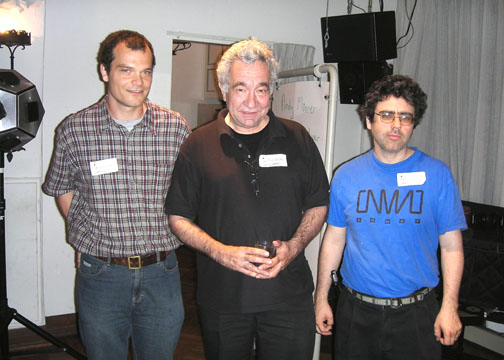Report on San Francisco AES chapterís May 2004 meeting, by Thomas Merklein
AES San Francisco's May, 2004 meeting was held at CNMAT (Center for New
Music & Audio
Technologies) at the University of California, Berkeley. CNMAT's
research orientation is live
performance in which computers are used to process sensor data that captures
musicians' gestures, to analyze
these gestures, to control sound synthesizers and compositional algorithms,
and to diffuse the sound. The
purpose of the meeting was to present current research.
Dr. David Wessel discussed the concept of gesture controllers that can be
used as musical instruments. A gesture controller might include a MIDI
interface, sensors to monitor finger location and pressure, and the ability to
generate polyphonic and continuous sounds. One of the challenges in
designing instrumental systems involves reducing latency to less than 10
milliseconds. Dr. Wessel demonstrated a Wacom tablet interface by
playing a piece that used 800 independently-controlled oscillators on 8
channels running on a Mac laptop.
Dr. Wessel also mentioned some of the merits of the Open Sound Control (OSC)
protocol. OSC provides a mechanism for passing bundles of control
parameters to a synthesis or compositional algorithm at one instant of time.
This is particularly important if the system needs to change numerous filter
coefficients. OSC is completely arbitrary in terms of sampling rates in
the various systems.
The Sound Description Interchange Format (SDIF) was also discussed. The
idea of this format is to have some level of abstraction for describing sounds
that would allow systems to perform various transformations on them. An
advantage to having such a standard representation is that developers can
begin to think about sound editors that operate on the abstract representation
rather than on individual sounds.
Dr. Adrian Freed discussed his work on the Connectivity Processor, a unit that
controls and distributes multichannel audio and gestural I/O over ethernet.
The system contains a baseline of digital and analogue audio standards, such
as MIDI, SPDIF, clock sync, ADAT, 2 ethernet ports, 8 channels of balanced
D-to-A, and a headphone output. An
ethernet bus was chosen because it's a widely available and non-proprietary
bus; it's much faster to design with; it is a fraction of the complexity of
Firewire and USB; and it is currently the most optimized path to the PowerPC
and Intel PC processors.
Despite the use of Gigabit Ethernet, there are nevertheless latency issues to
contend with. Adrian detailed the junctures in a system in which these
occur, from the gesture input, through the system, all the way to the final
audio out. In terms of PC OSs, Linux (tuned) has the lowest driver
latency; Windows is the slowest. CNMAT researchers have turned away from
DSPs because they are too slow. Apple and Intel-based computers offer
faster processors;
now the bottlenecks include the buses and memory. Dr. Freed demonstrated
the Connectivity Processor
using an electric guitar routed through a wah-wah pedal designed to phase
through other vowel sounds. He also showed a laptop-based guitar
retuning utility.
Peter Kassakian, a PhD student, is researching the ability to accurately
recreate instruments' dynamic radiation patterns using a programmable vector
space approach. His demonstration consisted of a comparison between a
small gong and the same sound played through a 12-speaker dodecahedron.

The presenters, from left: Peter Kassakian, Dr. David Wessel, Dr. Adrian Freed.
